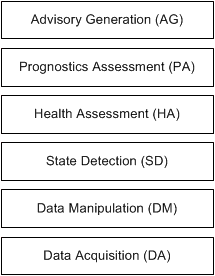Open System Architecture for Condition-Based Maintenance
What is OSA-CBM?
The OSA-CBM specification is a standard architecture for moving information in a condition-based maintenance system. A more in depth look reveals a way to reduce costs, improve interoperability, increase competition, incorporate design changes, and further cooperation in the realm of condition-based maintenance.
Project managers implementing condition-based maintenance systems must take on the task of integrating a wide variety of software and hardware components as well as developing a framework for these components. OSA-CBM simplifies this process by specifying a standard architecture and framework for implementing condition-based maintenance systems. It describes the six functional blocks of CBM systems, as well as the interfaces between those blocks. The standard provides a means to integrate many disparate components and eases the process by specifying the inputs and outputs between the components. In short, it describes a standardized information delivery system for condition based monitoring. It describes the information that is moved around and how to move it. It also has built in meta-data to describe the processing that is occurring.
The OSA-CBM is defined using the Unified Modeling Language (UML) and is designed as a “multi-technological implementation”, meaning that it separates the information that can be exchanged in a condition-based maintenance system from the technical interfaces system integrators use to communicate the information. Vendors and integrators can implement the standard using the appropriate technology for their environment. For example, while aircraft health management vendors may elect to use a “real-time” implementation, a vendor developing a portable maintenance aid may elect to implement the standard using XML and web services.

Who developed it?
OSA-CBM was developed in 2001 by an industry led team partially funded by the Navy through a Dual Use Science and Technology (DUST) program. At the time, no framework or standard existed for implementing CBM systems. The team’s participants covered a wide range of industrial, commercial, and military applications of CBM technology: Boeing, Caterpillar, Rockwell Automation, Rockwell Science Center, Newport News Shipbuilding, and Oceana Sensor Technologies. Other team contributors include the Penn State University / Applied Research Laboratory and MIMOSA.
Why did they develop it?
The U.S. Navy expends billions of dollars every year for maintenance. Most of the costs are in the form of manpower and part of the costs comes from proprietary software and hardware. To control increasing costs the Navy came to industry for ideas, support, and interchangeability standards. The goal was that standardization of information exchange specifications within the community of CBM users would ideally drive the CBM supplier base to produce interchangeable hardware and software components. The team envisioned that a widely adopted open standard would result in a free market for CBM components. There existed a need for an Open System Architecture to facilitate the integration and interchangeability of these components from a variety of sources.
What are the benefits?
- Cost – OSA-CBM can provide significant cost savings because system integrators and vendors will not have to spend time creating new or proprietary architectures. Savings will also come from not being committed to single vendors developing entire CBM systems. Since the standard is broken into functional components, multiple vendors may compete to develop select blocks of functionality.
- Specialization – When vendors are not constrained to providing an entire CBM system, they can concentrate on one or few areas. The increase in specialization will allow for better algorithms and technology to be developed. Smaller companies that could not provide an entire CBM system can now specialize in one or more of the functional blocks.
- Competition – OSA-CBM allows all vendors to use the same input and output interfaces. The separation of functionality from how the information is presented to other applications allows direct comparison of the developed functionalities. Competition now can occur at a functional level, not a system or total solution level.
- Cooperation – Not only can competition increase, but cooperation can also. The sectioning of CBM into separate independent blocks will allow multiple vendors to each work on separate modules. Since the standard also defines the interfaces, each module will be able to communicate with the others seamlessly if developed using the same technologies.
How does it relate to ISO-13374 and OSA-EAI?
ISO-13374, Condition Monitory and Diagnostics of Machines, defines the six blocks of functionality in a condition monitoring system, as well as the general inputs and outputs of those six blocks. OSA-CBM is an implementation of the ISO-13374 functional specification. OSA-CBM adds data structures and defines interface methods for the functionality blocks defined by the ISO standard.
The Open Systems Architecture for Enterprise Application Integration (OSA-EAI) is another MIMOSA standard. OSA-EAI defines data structures for storing and moving collective information about all aspects of equipment, including platform health and future capability, into enterprise applications. This includes the physical configuration of platforms as well as reliability, condition, and maintenance of platforms, systems, and subsystems. OSA-CBM uses many of the data elements that are defined by the OSA-EAI. The goal is to have OSA-CBM map into OSA-EAI, with future releases.
Releases
The MIMOSA OSA-CBM is released under the MIMOSA License Agreement.
| Title | Release Date | Version | Download |
|---|---|---|---|
| OSA-CBM 3.3.1 | June 29, 2010 | 3.3.1 | |
| OSA-CBM 3.3.0 | December 24, 2009 | 3.3.0 | |
| OSA-CBM 3.2 | September 12, 2008 | 3.2 | |
| OSA-CBM 3.1l | December 30, 2006 | 3.1l | |
| OSA-CBM 3.1h | August 1, 2006 | 3.1h |
OSA-CBM Software Development Kit
The OSA-CBM Software Development Kit for .NET should be your starting point for building your first OSA-CBM system because it will help you over the first hurdles. It is not, however, a commercial grade implementation. The SDK includes:
- OSA-CBM implementation guide
- README file
- WSDL file
- XML schemas
- Generic layer code
- Web service code



